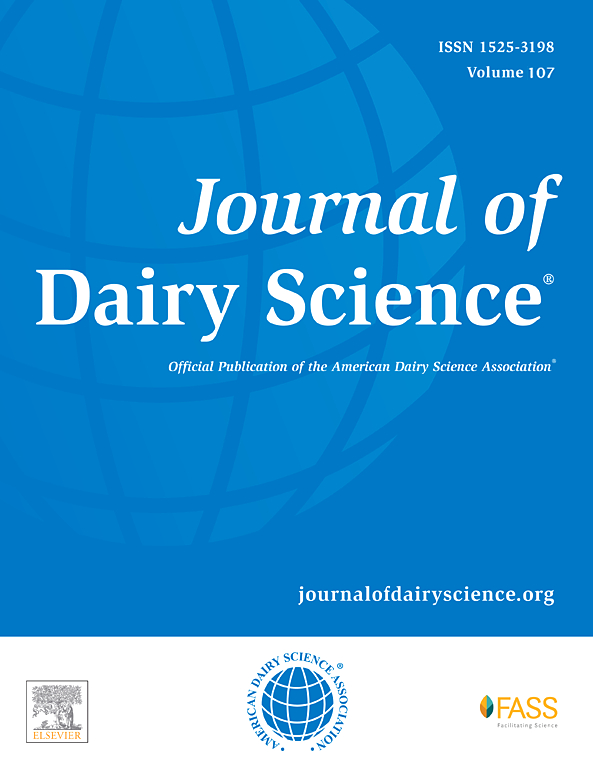Extrinsic attributes that drive consumer purchase of block mozzarella
IF 3.7
1区 农林科学
Q1 AGRICULTURE, DAIRY & ANIMAL SCIENCE
引用次数: 0
Abstract
Consumer demand for cheese continues to increase with mozzarella being one of the primary cheeses in the United States. The objective of this study was to understand the effect of extrinsic attributes on consumer desires for block mozzarella cheese. An online survey was conducted with mozzarella consumers (n = 437). Adaptive choice-based conjoint and Kano modeling were used to determine the importance of attributes applicable to block mozzarella. Maximum difference scaling was applied to further quantify the appeal of 23 label claims or messages. Subsequently, 2.5-h immersive qualitative focus groups were conducted (n = 28 consumers) that included mozzarella usage occasion discussion, naming identification, block mozzarella sorting, label discussion, and group tasting. Survey data were evaluated by univariate and multivariate statistics. The ideal block mozzarella for consumers was made from whole milk, had a firm texture or shreds well, block or bar shape, with a resealable package and farmer-owned labeling. Milkfat amount and label claims were the most important attributes (P < 0.05) across all consumers from conjoint analysis. Consumers found “produced without added hormones,” “made with milk from our pasture-raised cows,” and “made locally” to be the most appealing label claims. Consumer segmentation identified a natural cluster (n = 243) which assigned high utility to claims such as “all natural” and “organic” while the flavor cluster (n = 194) assigned high utility to “established business for more than 75 years” and “#1 in Italy.” Melt was a must-have attribute for mozzarella consumers while easy to shred and slice was a performance attribute. Block mozzarella is generally a price-driven product, except for special occasions where consumers seek out block mozzarella that they perceive to be of higher quality.
促使消费者购买块状马苏里拉奶酪的外在因素。
消费者对奶酪的需求持续增长,马苏里拉奶酪是美国的主要奶酪之一。这项研究的目的是了解外在属性对消费者对块状马苏里拉奶酪需求的影响。对马苏里拉奶酪消费者(n = 437)进行了在线调查。利用自适应选择联合(ACBC)和卡诺建模来确定适用于块状马苏里拉奶酪的属性的重要性。应用最大差异(MXD)比例进一步量化了 23 项标签声明/信息的吸引力。随后,进行了 2.5 小时的沉浸式定性焦点小组讨论(n = 28 名消费者),包括马苏里拉奶酪使用场合讨论、命名识别、块状马苏里拉奶酪分类、标签讨论和小组品尝。调查数据通过单变量和多变量统计进行评估。消费者心目中理想的块状马苏里拉奶酪是由全脂牛奶制成的,质地结实/易碎,块状/条状,包装可重复封口,标签由农场主拥有。通过联合分析,乳脂含量和标签声明是所有消费者最看重的属性(P < 0.05)。消费者认为 "不添加激素"、"使用牧场饲养的奶牛生产的牛奶 "和 "本地生产 "是最有吸引力的标签声明。消费者细分发现,"纯天然 "群组(n = 243)对 "全天然 "和 "有机 "等声称具有很高的效用,而 "风味 "群组(n = 194)则对 "经营超过 75 年 "和 "意大利排名第一 "具有很高的效用。融化是马苏里拉奶酪消费者的必备属性,而易于切丝和切片则是其性能属性。块状马苏里拉奶酪通常是价格驱动型产品,除非在特殊场合,消费者会选择他们认为质量更高的块状马苏里拉奶酪。
本文章由计算机程序翻译,如有差异,请以英文原文为准。
求助全文
约1分钟内获得全文
求助全文
来源期刊

Journal of Dairy Science
农林科学-奶制品与动物科学
CiteScore
7.90
自引率
17.10%
发文量
784
审稿时长
4.2 months
期刊介绍:
The official journal of the American Dairy Science Association®, Journal of Dairy Science® (JDS) is the leading peer-reviewed general dairy research journal in the world. JDS readers represent education, industry, and government agencies in more than 70 countries with interests in biochemistry, breeding, economics, engineering, environment, food science, genetics, microbiology, nutrition, pathology, physiology, processing, public health, quality assurance, and sanitation.
 求助内容:
求助内容: 应助结果提醒方式:
应助结果提醒方式:


